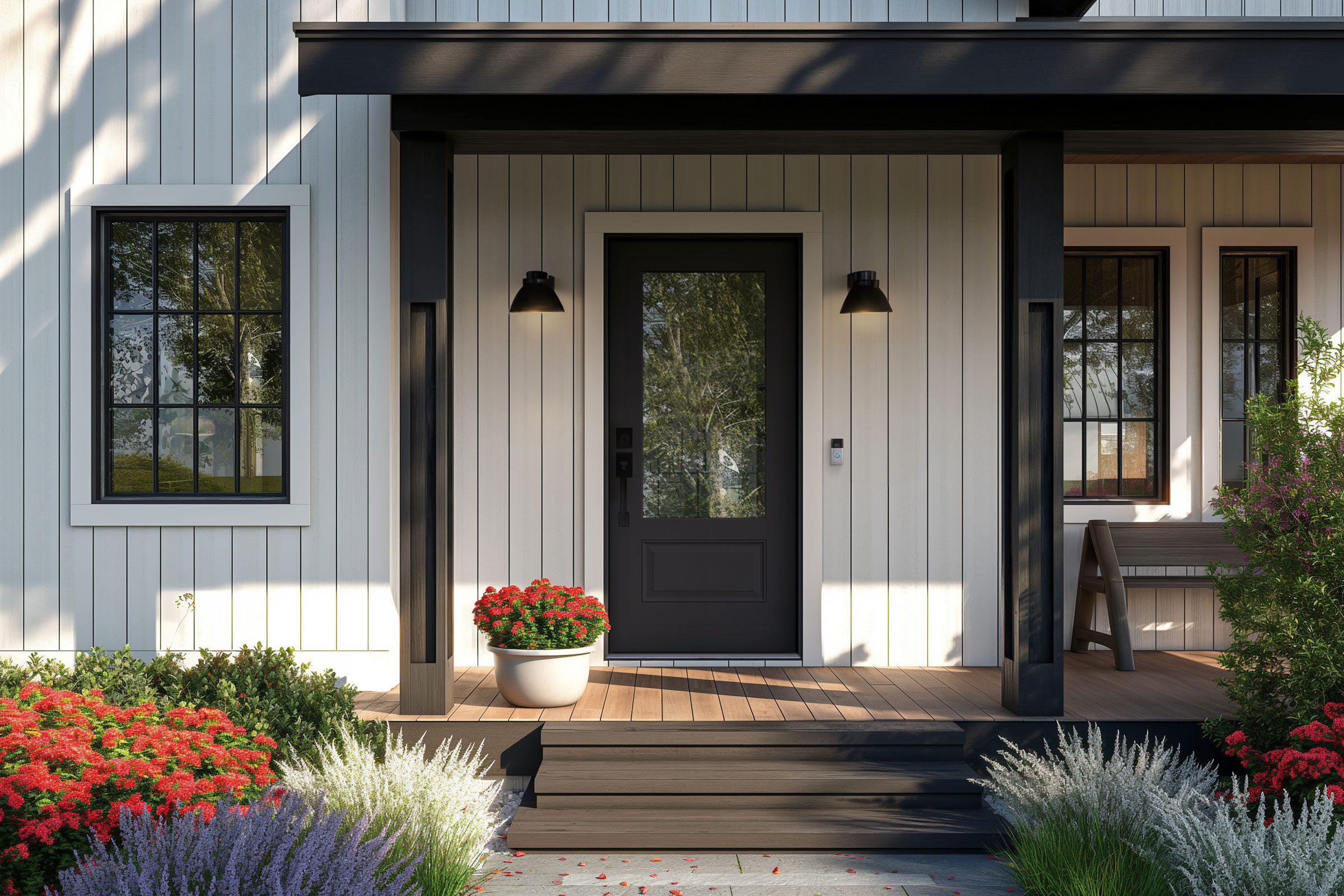Story at a glance:
- Energy-efficient doors are intentionally designed to reduce energy use and waste by prioritizing the use of non-conductive materials and effective air sealing strategies.
- There are three measurements that speak to a door’s energy efficiency: the R-value, U-factor, and solar heat gain coefficient.
- The main material, frame, weather-stripping, glass-to-door ratio, core, insulation, and even installation all greatly influence a door’s overall energy efficiency.
It’s estimated that windows and doors account for approximately 25% of the energy used to heat and cool buildings, with much of that being wasted via conduction or faulty seals, according to Natural Resources Canada.
Of the two, windows are usually the worst offenders when it comes to wasting energy, but exterior doors can still be partially responsible for increased HVAC system usage as a result of poor installation, faulty weather-stripping, or being built from highly conductive materials with low insulative properties.
To help save energy and reduce operating costs it’s recommended older doors be replaced by energy-efficient alternatives like those bearing an ENERGY STAR label.
What is an Energy-Efficient Door?
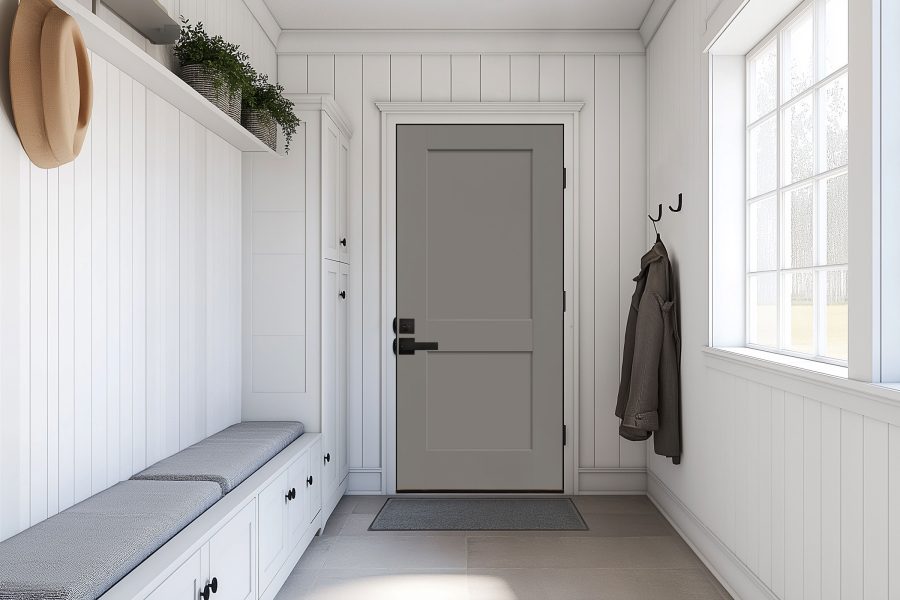
ODL is a leading manufacturer of energy efficient doors. Photo courtesy of ODL
An energy-efficient door is any exterior-facing door that has been specifically designed to prevent excess heat from entering a building in the summer and escaping in the winter—a feat achieved through the use of materials and techniques that effectively seal air leaks and improve insulation. When installed correctly energy-efficient doors help homes and other structures save energy and reduce their operating costs.
One of the easiest ways to identify an energy-efficient door is to look for those bearing an ENERGY STAR label. ENERGY STAR is a program developed by the EPA and DOE that provides information on the energy efficiency of various devices and products. On average ENERGY STAR certified doors help reduce energy bills by approximately 12%.
There are three measurements used to describe and quantify a door’s overall energy efficiency: R-Value, U-Factor, and Solar Heat Gain Coefficient (SHGC).
- R-Value. Describes a material’s capacity to resist heat flow; the higher the R-value, the better a material is at insulating.
- U-Factor. Describes the rate at which a door or window, along with all of its components, transmits non-solar heat flow; U-factor is expressed as a decimal between 0 and 2, with lower figures providing better insulation.
- SHGC. Describes the amount of solar radiation that passes through glass in a door or window; SHGC is expressed as a decimal between 0 and 1, with lower figures admitting less solar radiation.
In essence R-value refers primarily to the insulative capabilities of an individual material whereas the U-factor describes the insulative properties of the entire door system. SHGC is used exclusively in relation to glass, which may or may not be present in an exterior door.
How Do You Know a Door is Energy-Efficient?
If you are purchasing pre-made or pre-hung doors the easiest way to confirm whether they are energy efficient or not is to look for an ENERGY STAR label. ENERGY STAR is a program developed by the EPA and DOE that provides information on the energy efficiency of various devices and products. On average, ENERGY STAR certified doors help reduce energy bills by approximately 12%.
ENERGY STAR certification is only based on the U-factor and SHGC, with different glass-to-door ratios possessing different criteria depending on climatic zones, of which there are four: Northern, North-Central, South-Central, and Southern. ENERGY STAR certified doors are subject to the following standards:
- Opaque. All climate zones; doors must possess a U-factor of ≤ 0.17.
- ≤ Half Glass. All climate zones; doors must possess a U-factor and SHGC that is ≤ 0.23.
- > Half Glass. Doors in the Northern and North-Central zones must possess a U-factor that is ≤ 0.26 and an SHGC that is ≤ 0.40; doors in Southern or South-Central zones must possess a U-factor that is ≤ 0.28 and an SHGC that is ≤ 0.23.
Types of Materials for Energy-Efficient Doors
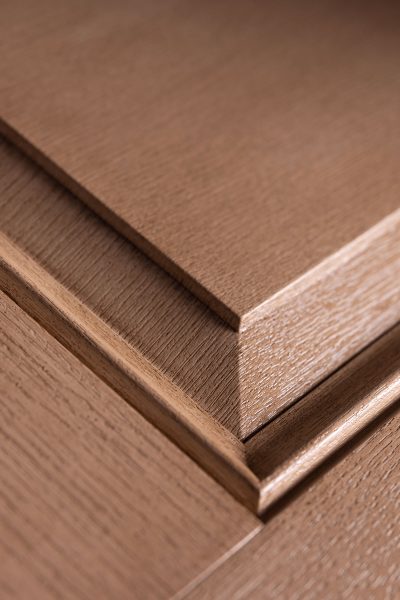
Fiberglass is an extremely popular material for constructing energy efficient doors and can be finished to look like wood grain. Photo courtesy of ODL
When it comes to determining a door’s energy efficiency the most important factor is the material used to construct the door slab itself. This is because different materials have different R-values and so offer varying amounts of natural insulation.
Wood
As one of oldest materials used to construct doors it should come as no surprise that wood ranks highly when it comes to energy efficiency. A natural thermal insulator, wood does an admirable job at preventing heat transfer, with most solid wood doors possessing an R-value between 3 or 4. Wooden doors are commonly made from Douglas fir, mahogany, white oak, or walnut, all of which offer durability and a timeless versatility that never goes out of style.
Unlike aluminum, steel, and fiberglass doors however, most wooden doors do not possess the capacity for additional insulation. In order to increase their R-value, wooden doors must increase in thickness—something that isn’t always practical or desired.
Other disadvantages associated with wooden doors include susceptibility to termites and other wood-eating insects, rotting, and moisture damage—the latter of which can lead to warping and misalignment, increasing the likelihood of air leaks. Fortunately these can be avoided as long as the door receives proper maintenance throughout its lifetime.
Steel
Another common material used in contemporary door construction is steel. Steel doors have a reputation for being sturdy and are capable of withstanding the elements with ease, though they are susceptible to denting from blunt-force impacts. Once installed, steel doors are relatively low maintenance and will not warp, swell, or rot like wooden doors.
In terms of energy efficiency, steel doors offer very little by way of insulation due to being natural conductors; most steel doors are not, in fact, solid metal but consist of a thin metal skin, an inner frame made of either wood or steel, and a high-density insulated foam core. Steel overhead doors lack the inner frame but are still capable of housing an insulated foam core. Insulated steel doors typically possess an R-value between 5 and 6.
Most steel entry doors are coated with a baked-on polyester finish or a weather-resistant vinyl coating and may either be smooth or feature an embossed wood grain pattern.
Fiberglass
Fiberglass doors are amongst the most popular energy-efficient doors on the market because of their extremely low rate of conductivity—which shouldn’t come as a surprise given the widespread use of fiberglass as an insulation material. “Every year we see fiberglass doors taking over more of the market share,” Denise Quinnette, executive vice president of engineering and product management at ODL Doors, previously told gb&d.
Made from reinforced plastic strands interwoven at random with glass fibers, fiberglass is an incredibly durable and lightweight material often used as an alternative to wood and metal. When used in door construction alongside insulating foam, fiberglass offers excellent energy-efficiency, with most fiberglass doors possessing an R-value of 6.
Aesthetically fiberglass doors are also incredibly versatile and can be treated to resemble solid wood doors. ODL—a leading provider of door and glass solutions—for example, offers a variety of energy-efficient fiberglass doors that provide the look of wood without the downsides.
Wrought Iron
Though not common, wrought iron doors offer a nigh-unparalleled aesthetic as well as incredible energy efficiency. Similar to steel, wrought iron on its own is an excellent thermal conductor and so is not used to construct the door in its entirety (that would be obscenely heavy) but a hollow skin or shell. The core of this shell is then injected and filled with polyurethane foam insulation, significantly increasing the door’s ability to block heat transference into and out of a building.
Some of the highest quality wrought iron doors boast R-values in the 6.5+ range and U-factors as low as 0.24. Aside from their excellent energy-efficiency, wrought iron doors are also very attractive and incredibly secure.
Keep in mind that wrought iron doors are one of the most expensive options on the market and so may not be compatible with all budgets.
Energy-Efficient Glass Doors

YKK AP’s StyleView sliding glass doors are aluminum-reinforced for added durability. Photo courtesy of YKK AP
Another important factor influencing a door’s energy efficiency is the amount of glass it features as this greatly impacts its overall U-factor and adds SHGC to the equation. Most residential entry doors do not have a high glass-to-door ratio but the same can’t be said for sliding glass doors, patio doors, and most store-front doors, of which are almost entirely composed of glass.
Energy-efficient doors with a high glass-to-door ratio share many qualities with energy-efficient windows. If you are considering installing exterior doors featuring a large amount of glass for your project, take the following into account:
Number of Panels
By definition any glass sections in an energy-efficient door must contain at least two panes of glass, though there are also triple-pane varieties on the market. In both cases an inert gas (such as krypton or argon) is used to fill the spaces between panes, which in turn helps improve insulation against unwanted heat transfer into or out of the building.
Increasing the number of glass panes—or glazes as they’re sometimes called—also lowers the door’s overall U-value, as multiple panes reduces the overall rate of conduction.
Low-E Coatings
To improve their efficiency further, doors featuring glass panels can also make use of a variety of coatings, such as low-emissivity film. Low-E coating is a transparent, microscopically thin layer of film that typically contains metallic particles, which help to reflect long-wave infrared energy without compromising visibility.
Low-E coatings are the most effective means to lower a glass panel’s SHGC and have become a standard for many manufacturers, although different coatings offer varying levels of protection. YKK AP’s StyleView line of sliding glass doors, for example, utilizes 366 low-E glazing that reduces heat gain by 64% and blocks 95% of the sun’s UV rays.
Smart Glass
Doors with a high glass-to-door ratio can also incorporate electrically-switchable smart glass for increased efficiency. Upon voltage application, smart glass automatically adjusts its tint or opacity to reduce the amount of solar thermal energy admittance.
And while smart glass technologies are much more common in windows, companies like ODL have begun experimenting with smart glass solutions in their doors, incorporating technologies that automatically adjust the opacity of the glass in response to sunlight levels and obscure views from the outside for privacy. “Right now those are two different technologies, but we’ll be looking to see how we could accomplish both of those with the same tech,” Quinnette says.
Energy-Efficient Door Frame Materials

Milgard uses a special vinyl blend to create energy-efficient door frames. Photo courtesy of Milgard
In addition to the material used to construct the door itself, the material used for a door’s frame also influences its overall energy efficiency.
Wood
We’ve already covered the thermal benefits of wood when used to construct the door itself, and these advantages are present in wooden door frames as well. Wood also has the advantage of being a highly sustainable option. That said, wood-framed doors can be expensive, require the most maintenance, and are susceptible to moisture, rot, and insect damage if not properly taken care of.
Insulated Aluminum & Steel
Door frames can also be made from metals like aluminum or steel. As long as they contain thermal breaks—that is, insulative barriers that minimize heat transfer between the exterior and interior frames—metal door frames offer comparable or better thermal resistance than wooden door frames. Thermally-broken metal framing is especially common in sliding glass doors systems, although it can be used in traditional exterior swing door systems as well.
Insulated metal door frames typically require less maintenance than wooden frames, though they may suffer from moisture damage in the form of rust if they are not properly looked after.
Vinyl & Fiberglass
For optimal efficiency, it’s recommended that you choose vinyl or fiberglass frames for your project’s exterior doors. Both vinyl and fiberglass are extremely durable materials that are water- and weather-proof while also being incredibly resilient to changes in temperature and humidity. Fiberglass and vinyl also have a very low conductivity that can be improved upon even further by the addition of thermal breaks.
Milgard—a leading manufacturer of windows and door systems—uses a unique vinyl formula to create low-maintenance, durable, energy efficient, and aesthetically-pleasing doors. “Vinyl is a great material to work with, and it’s recyclable,” Kevin Anez, director of product management for Milgard Windows & Doors, previously told gb&d. “What makes our product different is that we use a special blend of PVC that gives us a consistent wall thickness, which is important in maintaining certain performance categories.”
Factors That Influence Door Energy Efficiency
Aside from the materials used, there are a number of other factors that influence a door’s overall energy efficiency.
Core & Insulation
A door’s core also influences its overall energy efficiency. Most contemporary doors are either hollow- or solid-core, with the former providing space for added insulation. Insulated hollow-core doors are generally considered to be the more energy-efficient option and typically use polyurethane or polystyrene insulation in foam or board form.
Solid-core doors, on the other hand, typically feature a core made from natural lumber or structural composite lumber, both of which offer some level of natural insulation. These doors are very durable but are prone to warping over time and may, depending on the thickness, possess a lower R-value and U-factor than doors featuring additional synthetic insulation.
Weather-Stripping
Weather-stripping describes the material used to prevent moisture and air from entering around the edges of doors, operable windows, and other movable building components. Damaged, ill-fitting, or completely non-existent weather-stripping is one of the easiest ways for air (and moisture) to leak into and out of a building.
Different doors require varying amounts of weather-stripping but the fact remains that all doors will require weather-stripping to maintain efficiency. Some of the most effective weather-stripping options for sealing doors include:
- Tension-seal. Can take the form of either a self-stick vinyl strip folded along its length in a V-shape or a springy strip of molded bronze; may be installed along the top and sides of a door.
- Reinforced Foam. A type of closed-cell foam attached to metal or wood strips; can be installed along the bottom of doors and door stops.
- Reinforced Vinyl. Type of rigid strip gasket attached to metal or wood; may be installed along the bottom of doors and door stops.
- Magnetic. Made of high-quality thermoplastic rubber and includes magnets in head and lock jamb strips; ideal for use along the top and sides of doors.
- Door Shoe. An aluminum attachment featuring a vinyl C-shaped insert; designed to seal the space beneath exterior doors.
- Fin-Seal. Type of pile weather-stripping featuring a plastic Mylar fin; used to sliding glass doors.
Different types of weather-stripping can be used in different areas on the same door. Properly installed weather-stripping should allow the door to open freely and seal well when closed.
Proper Installation
When it comes down to it, any door—even an ENERGY STAR rated one—is only as good as its installation. If a door isn’t installed or sealed properly it can allow air to leak in/out through gaps and cracks, in which case its energy-efficient properties are more or less negated.
To ensure your project’s doors are installed properly it is recommended that you hire experienced, verified professionals who possess the necessary licenses and insurance qualifications required by your local government. If the door’s manufacturer recommends certain installers, take their advice seriously.
Types of Doors That Can Be Energy-Efficient
All types of doors can, theoretically, be energy-efficient, but that’s not to say all types of doors are capable of providing the same level of energy savings. As a general rule any door with a low glass-to-door ratio has the most potential for energy efficiency.
Exterior & Entry Doors
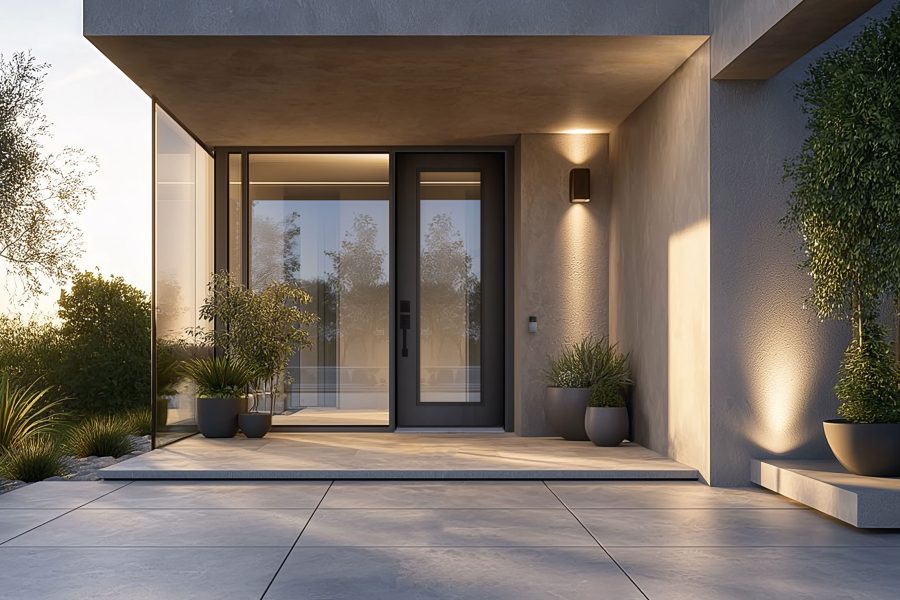
Photo courtesy of ODL
For the purposes of this article a classic exterior door is defined as any hinged door used as a means of entering or exiting a building. Traditional exterior doors typically have the smallest glass-to-door ratio and therefore have the most potential when it comes to energy efficiency, with the most important factor being the material used for the door slab itself.
Solid-core wooden exterior doors have decent insulative properties but insulated steel and fiberglass entry doors routinely possess higher U-factors and are considered to be the best option for exterior doors in regions that experience extreme temperature fluctuation.
Entryway doors that feature some amount of glass can be made energy-efficient through the use of low-emissivity coatings and double- or triple-pane insulated glass units. ODL Doors, for instance, offers low-E options for most of their exterior door systems.
Regardless of the slab material and glass-to-door ratio, all exterior doors have the capacity to reduce energy consumption as long as they feature adequate weather-stripping and are installed correctly.
Storm Doors
A storm door is a type of secondary door installed in front of an exterior access door designed to offer added protection against inclement weather and as an additional barrier against warm or cold air intrusion. Most modern storm doors are full-view and feature a single large panel of glass that may be changed out for a screen if desired (though this negates any potential for energy efficiency).
Some storm doors, however, are capable of housing both glass panels and screens at the same time. Referred to as ventilating storm doors, these doors consist of two glass panels and one to two screen panels; the glass panels may be moved up or down to reveal the screen and facilitate cross-ventilation.
When both the entry and storm door are closed, a glass-paneled storm door naturally provides an added layer of insulation; storm doors featuring low-e coatings and/or double- or triple-paned glass can improve the door’s energy efficiency by 29% compared to standard glass.
Sliding Glass Doors

The YSD 600 thermally broken architectural (AW) rated sliding glass door was designed to provide greater energy efficiency and occupant comfort. Photo courtesy of YKK AP
Sliding glass doors slide open horizontally rather than swing open and are either mounted on or suspended from a track; depending on the style, sliding doors open by sliding parallel to or into a wall. Sliding doors typically consist of a large pane or several small panes of glass held in place by a fiberglass or aluminum frame.
Similar to energy-efficient windows, sliding doors can be made efficient by using double- or triple-paned glass, low-e coatings, and proper weatherstripping to prevent air and moisture leakage. The best type of weatherstripping for sliding glass doors is fin-seal or brush-fin.
To prevent excessive heat loss and gain through a sliding glass door’s frame, it’s recommended that you choose insulated fiberglass or insulated aluminum framing. YKK AP, for example, offers a variety of sliding aluminum glass doors—such as the YSD 600 and heavy duty YSD 400—featuring their signature MegaTherm aluminum framing system. Nylon polyamide glass fiber reinforced pressure extruded bars are used to join two separate extrusions into one thermally-broken aluminum frame, providing unmatched durability and performance.
French Doors
French doors consist of a pair of evenly-split doors that are of light construction and which typically feature extensive glass paneling separated by metal/fiberglass framing or, more traditionally, wooden partitions. These doors are hinged, open outwards, and are frequently used in a residential context to allow access to a deck, porch, or patio.
As long as they are properly installed French doors can be made energy efficient through the use of low-emissivity double- or triple-paned glass, insulated fiberglass framing, adequate weather-stripping, and the inclusion of a door sweep.
Because French doors consist primarily of glass, they will never be as energy-efficient as, say, a standard entry door.
Overhead & Garage Doors
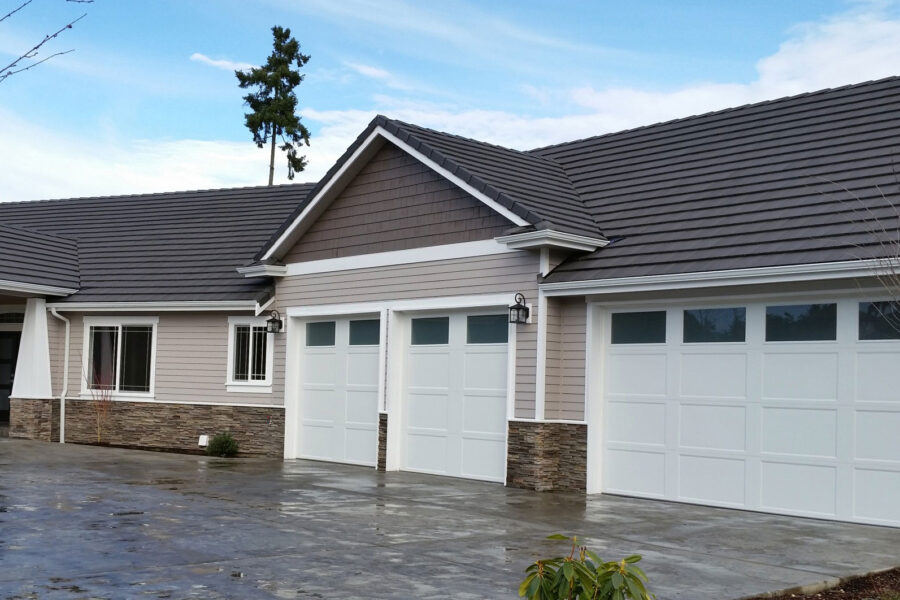
Hörmann’s Therma Style 5500 garage doors have an R-10.4 thermal rating. Photo courtesy of Hörmann Group North America
Encompassing all doors used to cover the large opening of a garage or any space through which a vehicle may enter, overhead and garage doors come in three styles: roller, sectional, and counterweight. These doors may be opened manually or via an electric motor and the size of overhead doors can vary considerably depending on the size of the vehicles they must accommodate.
Residential garage doors are typically made from wood, metal, or fiberglass while industrial overhead doors are almost exclusively made from metal, usually steel or aluminum. This is often the case for commercial buildings as well, though some businesses like restaurants and cafés make use of overhead doors featuring extensive glass paneling.
Glass overhead doors have the lowest potential when it comes to energy-efficiency as they cannot be outfitted with additional insulation in the conventional sense and rely solely on insulated glass to improve their thermal performance. Wooden, aluminum, steel, vinyl, and fiberglass garage doors, on the other hand, can be outfitted with insulation to increase their overall energy-efficiency.
Hӧrmann Innovative Door Systems—a leading international garage and overhead door manufacturer—carries a wide range of high-performance garage doors whose thick polyurethane and polystyrene cores help them achieve impressive thermal efficiency. The company’s Therma Style 5500 carriage style garage doors, for example, feature steel skin and polystyrene core that delivers an R-10.4 thermal rating.
Bi-Fold Patio Doors
As a variation of the conventional sliding glass door, bi-fold patio doors consist of multiple hinged panels (typically between two and seven) that fold in on themselves as the door is slid open. Like sliding glass doors, bi-fold patio doors are mounted on or suspended from a track and use a series of wheels to slide open and closed.
Because they are constructed primarily of glass, bi-fold patio doors do not offer the same energy savings as traditional entry doors, though they can be made more energy-efficient through the use of double- or triple-paned glass coated with a low-emissivity film.
As with any door system, the true efficiency of a bi-fold patio door depends on how well it was installed and the weather-stripping it employs.
Tax Credits for Energy-Efficient Doors
While there technically aren’t any tax benefits or incentives designed specifically for energy-efficient doors, installing energy-efficient doors alongside other appliances and products can help both commercial and residential buildings qualify for certain energy-related tax credits.
Commercial Buildings
Energy-efficient doors can help commercial buildings—a designation that typically includes warehouses, retail buildings, libraries, apartment buildings with 4+ floors, office buildings, government-owned buildings, parking garages, industrial buildings, and public universities—qualify for the IRC Section 179D Commercial Buildings Energy-Efficiency Tax Deduction.
IRC Section 179D allows building owners of new or existing buildings to claim a tax deduction (up to $1.88 per square foot) for installing either interior lighting, building envelope, or heating, cooling, ventilation, or hot water systems that reduce the energy and power costs of interior lighting, hot water, and HVAC systems by at least 50% compared to buildings meeting the minimum requirements set by ASHRAE Standard 90.1.
Building owners can also use IRC Section 179D to claim a partial deduction (up to $0.63 per square foot) on individual building envelope systems that reduce the energy and power costs of interior lighting, hot water, and HVAC systems by at least 10%.
Under IRC Section 179D, exterior-facing doors fall under the category of “building envelope systems” and may be eligible for, or contribute to, qualification. Consult with a CPA or other tax professional to determine whether your business or property qualifies for this particular deduction, as every tax situation is unique.
Homes
Installing energy-efficient doors in the home can help homeowners qualify for the Energy Efficient Home Improvement Credit. As long as they have an expected lifespan of five years, exterior doors that meet applicable ENERGY STAR requirements are eligible for the deduction under the “Building Envelope Components” category; credit is limited to $250 per door and $500 total.
To be eligible for this credit the home must be in the US and be an existing residence. Landlords and property owners cannot claim this credit if they do not live in said residence for the majority of the tax year.
Consult with a licensed tax professional if you have questions about how the installation of energy-efficient doors relates to possible tax credits or deductions.
How to Choose Energy-Efficient Doors

YKK AP’s StyleView HD Sliding Doors are ENERGY STAR certified when glazed with low-E insulating glass. Photo courtesy of YKK AP
Choosing the right energy-efficient door can be a daunting task, but it doesn’t have to be. These steps will help you make the most informed decision.
1. Know Your Climate Zone
Before even picking a style or type of door, make sure you know what ENERGY STAR climate zone your project is in. You can access the ENERGY STAR climate zone map via their website. Select “Doors” from the “Product” dropdown menu and select the state and county your project is in.
Once you’ve entered the requested information the site will show the U-factor and SHGC criteria for doors in your climate zone based on different glazing amounts. Refer back to this criteria when it is time to compare doors.
2. Identify Door Type & Style
Now, consider the types and styles of doors needed for your project. This largely depends on personal preference, the preferences of a client, or accessibility requirements. Considering most types of doors have energy-efficient versions and are available in a range of styles, this step is more of a formality.
3. Look for ENERGY STAR Certification
Once you’ve narrowed down the type and style of door, it’s time to actually start looking at products. To ensure that the doors you ultimately end up choosing are designed with energy-efficiency in mind, only consider doors that bear an ENERGY STAR label, as these doors have been tested and meet the efficiency standards set by the EPA and DOE.
ENERGY STAR labels feature a map—the highlighted areas of the map are where the door has been certified for use (multiple climate zones may be highlighted).
With energy efficiency code requirements becoming increasingly rigorous nationwide, many door manufacturers have begun offering ENERGY STAR certified products. YKK AP’s StyleView line of sliding glass doors, for example, meet ENERGY STAR performance guidelines when glazed with low-E insulating glass.
4. Read the NFRC Label
After you’ve verified that the door you’re looking at is ENERGY STAR certified, look for its National Fenestration Rating Council (NFRC) label. NFRC labels contain a chart that provides the following information:
- Product Description. Leftmost column of the chart that gives a description of the door frame or glass; each cell in the column is a different configuration option available for that door.
- Glass Area. Topmost row of the chart that shows the amount of glass in the door by area (¼, ½, ¾, or full).
- Door-specific Rating. The circled value shows the SHGC and U-factor ratings for that specific configuration of the door.
NFRC labels are useful for comparing between energy-efficient products.
5. Compare Products
Use the NFRC labels to compare their U-factors and SHGC values. Regardless of the climate zone your project is in, it is generally recommended you choose the door with the lowest U-factor or the highest insulative potential.
When it comes to comparing SHGCs, the desired value largely depends on the project’s climate zone and whether the door will feature as a passive design element.
Doors with a very low SHGC are ideal for regions that experience hot summers and relatively mild winters, as these doors will help block unwanted solar heat gain and keep interiors cool. Doors with a higher SHGC, on the other hand, can be beneficial in regions that experience mild summers and extremely cold winters, as they help facilitate passive solar heating.
FAQs
Are steel doors energy-efficient?
While steel by itself is not a particularly energy-efficient material—indeed, it’s actually highly conductive—steel doors can be made energy-efficient as long as they feature an insulated core. Steel entry doors with an insulated core, for example, typically possess an R-value between R-5 and R-6.
Are all wood doors energy-efficient?
Despite wood’s status as a natural thermal insulator, not all wooden doors are energy-efficient—and even those that are considered energy-efficient typically possess lower U-factors and R-values than insulated steel and fiberglass doors.
This is largely because wooden doors typically do not feature additional insulation but instead rely on their thickness to increase insulative capacity. A 1 ¾-inch wooden door, for example, has an R-value of roughly 3.03, whereas a 2 ¼-inch solid-core wooden door has an approximate R-value of 3.70.
While not the most energy-efficient option on the market, wooden doors may be ideal in regions that do not experience extreme high and low temperatures, especially when they are properly sealed and installed.
Are wrought iron doors energy-efficient?
Though they might not look it, wrought iron doors—especially modern wrought iron doors—can be extremely energy-efficient. This is because contemporary wrought iron doors feature a highly insulative polyurethane foam core that offers year-round thermal protection. Wrought iron doors that include glass paneling can also be considered energy efficient as long as they use double- or triple-paned glass coated with a low-e film.
The best-in-class wrought iron doors boast an R-value of 20+ and a U-factor of up to 0.24.

